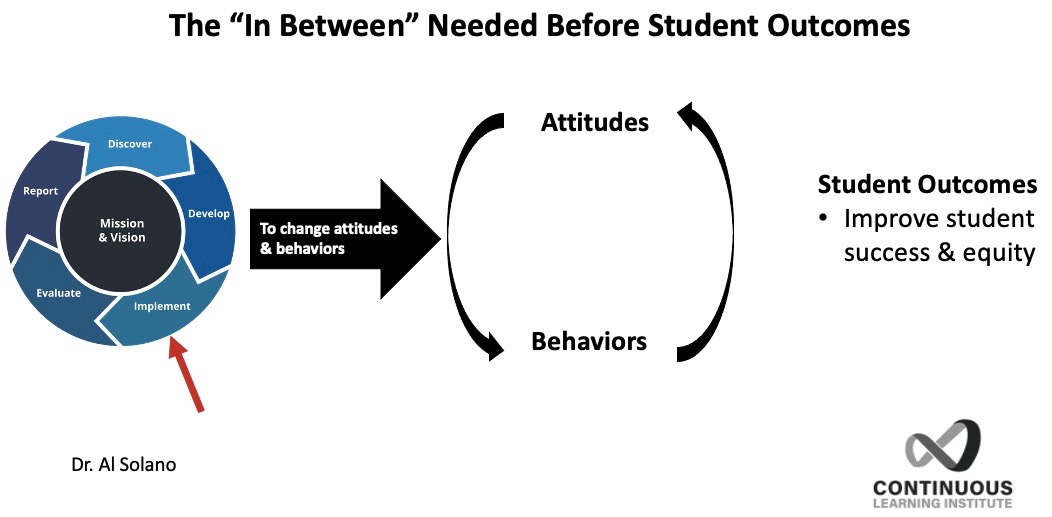The "In Between": What’s Needed to Improve Student Outcomes
September 4, 2021
[For a deeper explanation, please click on the video above.]
As institutions attempt to implement a variety of priorities, they understandably focus on the end result: improved student outcomes and equity. However, most educators miss something critical that needs to happen "in between" the priorities and improved outcomes.

For improved student success and equity outcomes to be realized, there needs to be changes in college educator attitudes and behaviors.[1]

Attitudes and behaviors are critical because we never truly know what percentage of educators are willing to improve equity, what percentage talk a big equity game but sit in the sidelines heckling those who actually do the work, percentage of those who are indifferent to equity, and the percentage of those who are anti-equity. I unpack this some more in the article and video, Guided Pathways & Equity: Structural & Cultural Change Typology.

Since we don't know these percentages, it's important to take an approach that will change as many hearts and minds as possible with one strategy, which I will explain in a moment. First consider this notion.
Change in attitudes follows or accompanies gradual change in behavior. For example, the faculty member who has had low expectations of students can adopt higher expectations if the faculty learns how to successfully teach toward that expectation, then sees student progress.[2]
Creating and supporting the conditions to allow for such gradual change in attitudes and behaviors is the key.
The strategy is simple yet highly underestimated: DO THE WORK!
First, how the work doesn't get done:
- Endless committee meeting discussions
- Discussions that lead to no action
- Allowing one or the few loud people to block the work with endless pontification
- Student-blaming and deficit mindsets
- Poor leadership
Example: Early guided pathways adoption whereby institutions focused on three areas.
1. Meta-major development (also known as Academic & Career Communities)
2. Program mapping development
3. Developmental ed reform

By doing the work, meaningful a-ha moments occur--collaboration and action that wouldn’t have happened instead of being stuck in discussions.

A perfect example is illustrated by a recent report by Just Equations, which analyzed developmental education reform in math. As explained in one my pieces, Transforming Instruction in Math, faculty participated in an inquiry and action process that helped them implement changes in the classroom. The experience of doing the work changed faculty attitudes and behaviors, which led to improved student outcomes and equity gap reductions.

Another example are the inquiry and action teams I've been coaching. These include: inquiry & action student success teams per meta-major (aka, academic & career community), pedagogy inquiry & action teams, and student services inquiry & action teams.
[Learn more about the process model known as the "Integrated Planning Model."]
Ironically, in the early stages of planning priorities, educators have a tendency to think about implementation first. When they focus on implementation, they think about all of the roadblocks and excuses of why change is impossible. I always encourage teams to start at the Discover phase. This phase is about creativity and imagination, take those creative ideas to the Develop phase, then implement them. The problem is that institutions too often can't escape the Discover and Develop phases. Case in point, institutions that took three to five years to create their meta-majors and first version of their program maps. And by creating meta-majors I mean they reside 3-5 clicks away on the college website, never to be used to improve the student experience. In other words, no implementation.

So, institutions need to reach the implementation stage in order to achieve "the in between." But how does the work get done?
- When people treat each other with kindness
- When there are productive workgroups with high quality leads to shepherd the work
- When the president, VPs, deans, academic senate, and classified professional leadership are helpful and supportive
- When people understand the “3-month rule” and therefore ensure steady momentum
More strategies are available in the free guide, Why Colleges Struggle to Implement Priorities & What To Do About It

Remember to be intentional about the "in between" and how to achieve it. Without the "in between"--in other words, culture change--improved student success and equity looks good in a planning document, but it ends up being a pipe dream.
Do the work.
***
Also visit: Transformational Change: Challenges & Opportunities | Foundational Ingredient For Successful Equity Work
[1] Adapted from Goldenberg, C., Saunders, B., & Gallimore, R. (2004, March).
Settings for change. A practical model for linking rhetoric and action to improve achievement of diverse students. Final Report to the Spencer Foundation.
[2] Dr. Ron Gallimore, UCLA Professor Emeritus (various conference presentations). Author, Rousing Minds to Life (1990) and You Haven't Taught Until They Have Learned (2010).







